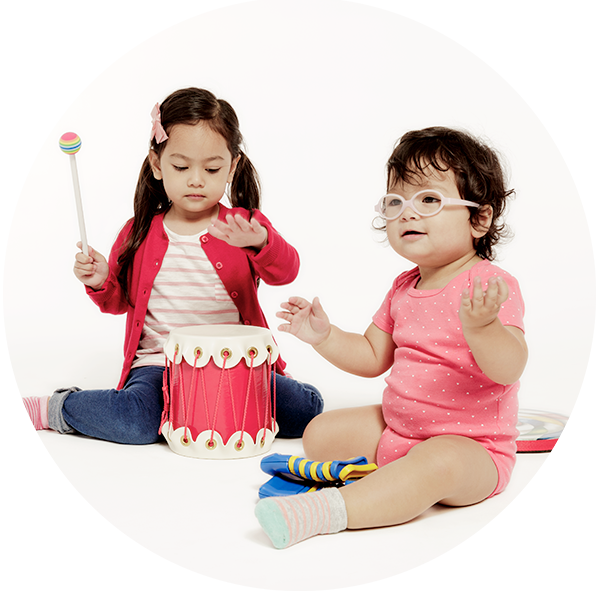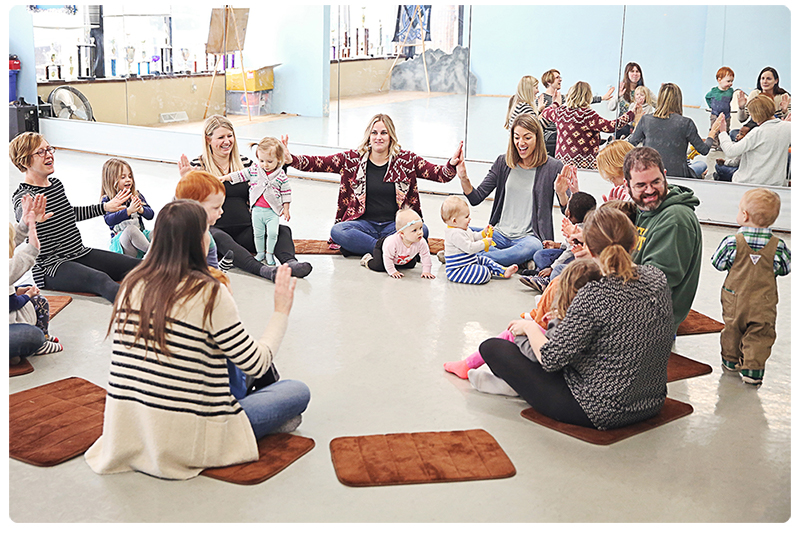The Surprising Benefits of Mixed-Age Classes

"Although humans are not usually born in litters, we seem to insist they be educated in them." - Dr. Lilian Katz
If you’re like many of us, you probably grew up learning in classrooms separated by age: First-graders in one room, second-graders in another, and so on. This is a common way to educate children, but it’s not the only way. You may have heard that Montessori schools combine multiple ages into each classroom, but did you know Music Together pioneered bringing mixed-age groupings to parent-child programs?
The resulting “family model” of early childhood education means that all members of a family can learn—and play!—together. Recent research on mixed-age classes highlights additional surprising benefits.
- Benefit #1: True Empathy. Babies are born with the raw material to develop empathy, which often shows up as a reflex to mirror emotion, like when one baby cries and others cry, too. But in order for this potential to become what researchers call “true empathy,” children have to receive and give caring. This is rare in same-age schooling, but opportunities for nurturing exchanges abound in mixed-age classes.
- Benefit #2: Meeting children’s unique needs. As a new parent, you may have joined a Baby Play Group to find support in parenting an infant for the first time. Finding community, comparing experiences, and sharing challenges all help new parents feel supported. (What a lifesaver these groups can be for parent and baby!) If, however, that baby never gets the opportunity to socialize, explore, and learn outside of this same-age group, key developmental needs will go unmet. As children grow, mixed-age settings provide the opportunity to be nurtured and mentored by older children, and to offer caring and leadership to younger children.
- Benefit #3: Learning by teaching, leading, and modeling. In mixed-age play, older children learn by teaching, become leaders, and model for younger children. The little ones, in turn, emulate older children’s skills. You probably learned to tie your shoes by watching an older sibling, neighbor, or friend—one who took the time to patiently show you how to make loops, cross over, and pull until you got it right. In mixed-age groupings, younger children naturally turn to older children for guidance, and older children instinctively offer help to the younger ones.
- Benefit #4: More creativity, less competition. When children of multiple ages play together, the focus shifts from competing for limited resources (like toys and attention) to having fun! Children have more chances for deep, imaginative play, for exploring new ideas, and for working together in novel ways. Parents, too, in a mixed-age classroom are less likely to compare their child to others. Nagging questions like, “Should my child be clapping, too?” are more likely to move into the background. Instead, they catch a glimpse of what’s ahead for their child and mentor other parents with a little “been there, done that” wisdom.
Luckily, Music Together families experience some of the benefits of mixed-age classes: fostering leadership, caring, empathy, and creativity—all of which support early music-learning and foster lifelong success in school and life.

Sources:
Anderson, L.S. (2018). Building Empathy, Strengthening Relationships: The Benefits of Multiage Classrooms for Young Children and Their Caregivers. Young Children, a NAEYC publication (https://www.naeyc.org/resources/pubs/yc/jul2018)
Gray, P. (2011). The Special Value of Children’s Mixed-Age Play. American Journal of Play, 3(4), 500-522.
Association for Childhood Education International http://www.uwyo.edu/ecec/_files/documents/multi-age-benefits.pdf
Stone, S. J. (1998). Teaching strategies: Creating contexts for middle-age learning. Childhood Education, 74(4), 234–236.
Veenman, S. (1996). Effects of Multigrade and Multi-Age Classes Reconsidered. Review of Educational Research.
Katz, Lilian (1995). The Benefits of Mixed Age Grouping.



